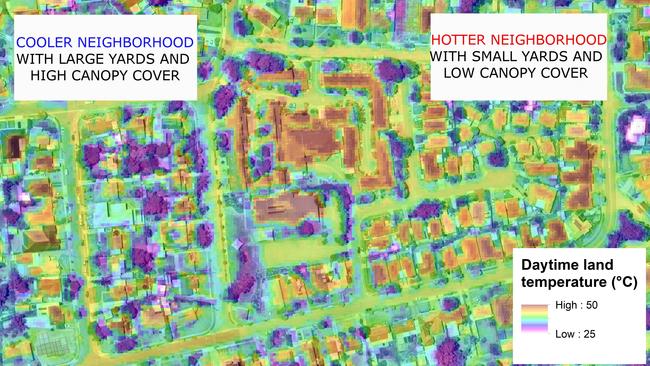AdaptWest and Smart Green Cities reveal the cooling effect of trees
On hot summer days and nights, leafy trees cool the land around our homes by up to six degrees, Adelaide research shows.
SA News
Don't miss out on the headlines from SA News. Followed categories will be added to My News.
- Urban heat mapping reveals Adeaide’s hottest and coolest suburbs
- Significant tree laws accelerating loss of vegetation, councils say
- Housing Industry Association SA on having to plant more trees
Trees, grass and other plants can lower the land-surface temperature by up to five or six degrees during a heatwave, Adelaide research has shown.
The AdaptWest consortium of councils in the west worked with Smart Green Cities at Macquarie University to study a series of urban heat maps.
AdaptWest regional co-ordinator Jeremy Miller said the aim was to better understand and quantify the role of trees in cooling the environment around homes on hot days.
“The trees we have in our front and backyards are really important,” he said.
“The cooling effect occurs where it is needed most, it helps keep our homes cool.”
Knowing more about the beneficial effect of trees, grass and other plants can help guide urban planning as heat becomes increasingly intense.
Private yards and gardens provide more than 40 per cent of the tree cover and 30 per cent of grass cover across the western surburbs.
“The problem is we’re losing a lot of those trees through urban infill,” Mr Miller said.
“We don’t have a problem with urban infill as a mechanism of densification, but we need to think about how we conserve, protect and retain as much of that canopy as possible, rather than clear-felling the site and filling it up with hard surfaces.”

Lead author and research coordinator Dr Alessandro Ossola said Adelaide had an opportunity now to use trees in private yards for cooling the suburbs.
“We measured that in some parts of Adelaide, if you green your property, you can actually have this five to six degrees benefit in cooling extreme events,” he said.
“To us it is very good news, we knew trees were important but now we have numbers and with numbers you can better inform policy-making and planning and you can convince communities.”
The research found the largest temperature reductions in the hottest suburbs, furthest from the coast.
The next step is to identify the best trees to plant now, placing priority on fast-growing species that are better able to survive recurrent extreme heat and drought.
Using data from the Bureau of Meteorology, the report also shows Adelaide suffered one of the steepest rates of maximum temperature increase among Australia’s cities and towns since the year 2000.
When the mean maximum annual temperature is plotted on a graph, the slope of the line is steeper for Adelaide, which means we are warming faster than other Australian cities.
“Unfortunately the city is at the forefront of climate change impacts, both nationally and internationally,” Dr Ossola said. “While this is putting a lot of pressure on people, it also represents a great opportunity for governments, communities and residents to envision and co-create a greener and more resilient Adelaide.”
Read the full report: Urban Trees and People’s Yards Mitigate Extreme Heat in Western Adelaide.

